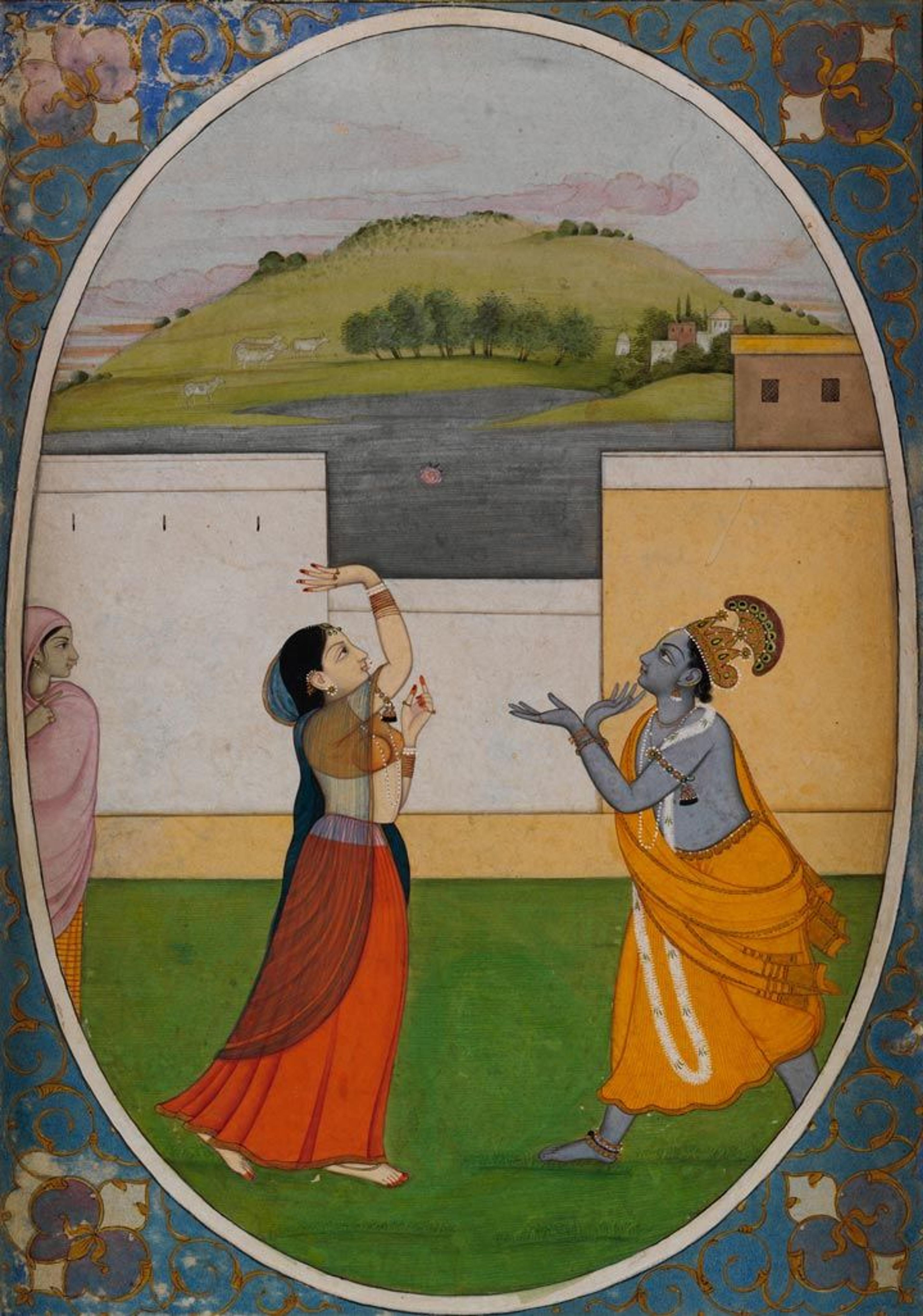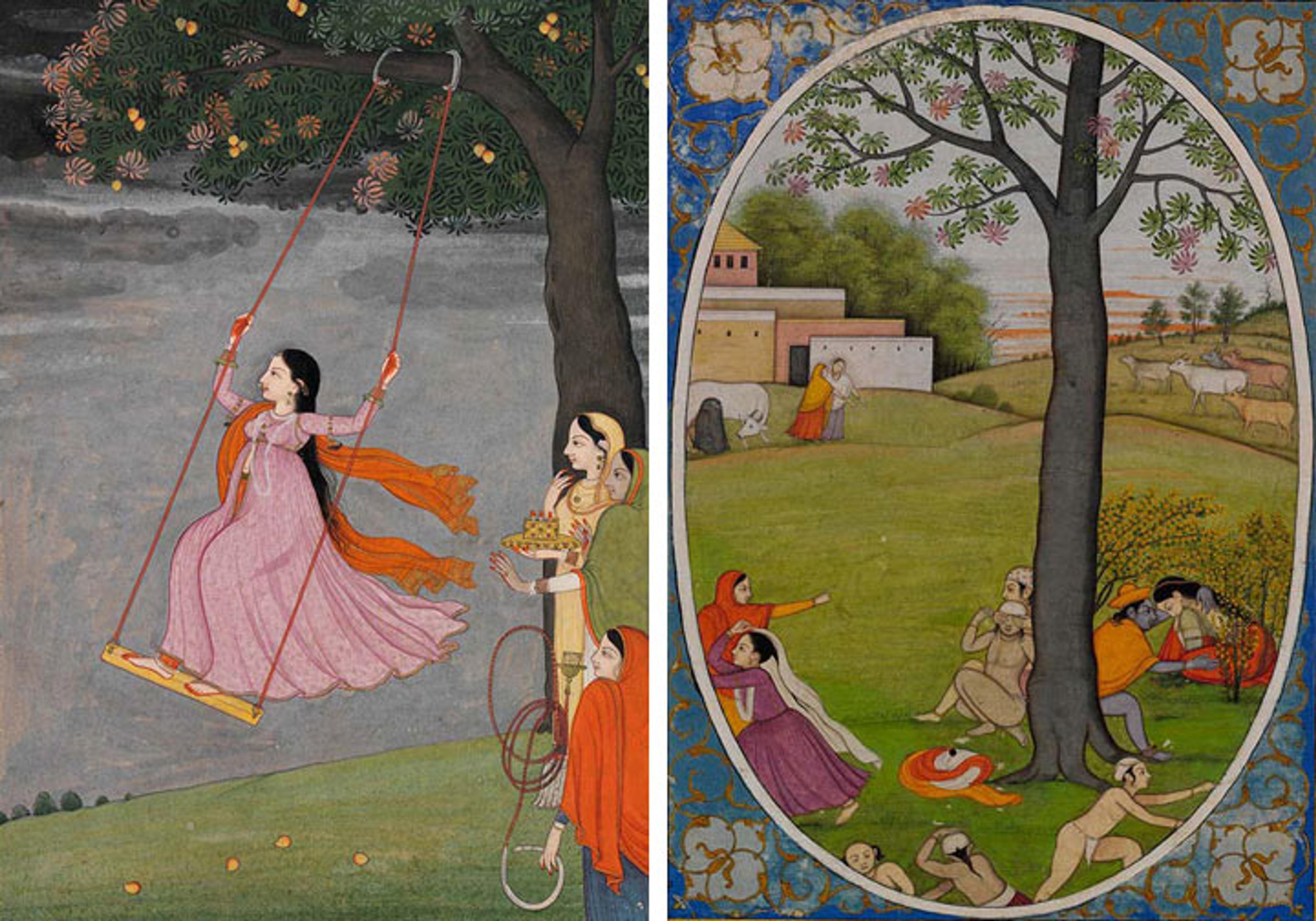Summer Love in Divine Pleasures: Poems and Paintings of Bihari's Sat Sai

Fattu. "Krishna and Radha Toss a Flower," Folio from the "Kangra Bihari" Sat Sai (Seven Hundred Verses), ca. 1785. India, Kangra, Punjab Hills. Opaque watercolor, ink, and gold on paper; Page: H. 7 7/16 in. (18.9 cm), W. 5 1/4 in. (13.3 cm); Painting: H. 8 1/8 in. (20.6 cm), W. 5 5/16 in. (15.1 cm). Promised Gift of the Kronos Collections, 2015
«As New Yorkers wait out the long, hot days of August, I recommend a visit to Divine Pleasures: Painting from India's Rajput Courts—The Kronos Collections, on view through September 12, 2016. After repeat viewings, I have come to see three paintings from the exhibition, all based on the poetry of the Sat Sai (Seven hundred Verses) of the Hindi poet Bihari Lal Chaube (1595–1663), as the quintessential images of summer love. In keeping with the romantic poetry of its time, the majority of the couplets in Bihari's Sat Sai describe the love and separation between a nayak and nayika (hero and heroine) who often take the form of the god Krishna and his beloved Radha. Although completed around 1785 in the kingdom of Kangra in the Punjab Hills, more than a century after the life of Bihari, these paintings nonetheless capture the mood, the flavor, the rasa of the original poems.»
The paintings and the poems they illustrate are pungent with the scent of love and the heat of passion. In one of the gouache-on-paper works on view (above), we encounter a seemingly chaste scene of the great lovers: the playful, blue-skinned Krishna and his chosen consort, Radha, tossing a pink flower back and forth. The most closely related couplet from Sat Sai tells a slightly different story of illicit flirtation between the nayak and nayika from the point of view of the heroine's friend:
Wherever the flowers,
Thrown playfully at her
By her husband's younger brother,
Who was her paramour,
Struck her,
Welts of joy appeared on her limbs!
Mistaking them for insect-bites
I hastened with the jar of ointment,
But when she smiled
I guessed the truth
And stayed my hands.
The scenario in the poem emerges from a common romantic trope of South Asian poetry, that of the young bride engaging in an affair with her amorous, unmarried brother-in-law. In its imagery, the poetry also plays between the best and the worst of summer: the itchiness of insect bites weighed against the "welts of joy" from a romantic tryst. In the painting, Radha wears a golden choli blouse and a mango-colored ghaghra skirt, and her translucent blue odhani shawl pulls back to reveal the skin of her slender waist. Seen alongside these poetic verses, the lady's bare skin becomes vulnerable to the love marks made by flowers that her friend mistakes for bites. The painting evokes the fleshy tension of Bihari's poetry, where the affairs of the heart find physical manifestation in the skin of divine bodies.
Other poems of Bihari refer to the heat generated by the lovers' passion for each other. In one poem, a friend shoos the nayak away from his beloved lady:
When she sees you near
Her ardour
Makes her perspire
Dampening again
The henna paste.
The lines suggest that the nayika has decorated her body with henna pigment, which needs to dry in order to properly dye the skin. Yet the lady is so excited by the presence of the nearby lover that she cannot stop sweating. When I read these lines, I thought of the many paintings in Divine Pleasures that depict beautiful women whose hands have been colored red and pink with henna and lac dye. In the burnished surface of the painting, I could almost see these ladies' hands and feet gleam with excitement at the approach of their lovers.

Left: A Lady on a Swing in the Monsoon, ca. 1750–75. India, Punjab Hills. Opaque watercolor and gold on paper; Page: H. 8 1/2 in. (21.6 cm), W. 6 5/16 in. (16 cm); Painting: H. 7 1/8 in. (18.1 cm), W. 5 in. (12.7 cm). Promised Gift of the Kronos Collections, 2015. Right: Fattu. "The Villagers Play Hide and Seek; Krishna Discovers Radha Hidden in a Clump of Bushes," Folio from the "Kangra Bihari" Sat Sai (Seven Hundred Verses), ca. 1785. India, Kangra, Punjab Hills. Opaque watercolor, ink, and gold on paper; Page: H. 8 1/8 in. (20.6 cm), W. 6 in. (15.2 cm); Painting: H. 7 7/16 in. (18.9 cm), W. 5 1/4 in. (13.3 cm). Promised Gift of the Kronos Collections, 2015
Another work based on the Sat Sai depicts a game of hide-and-seek or blind man's buff (chora-mihīchanī). In the above right painting, colorfully dressed ladies and bare-chested men run toward the outside edges of the painting in order to hide from the blindfolded boy by the tree, their bodies tumbling and lurching in the playful joy of the game. On the other side of the thick tree trunk, beneath flowering branches, the painter has given shade to the lovers, Radha and Krishna. The orange-clad figure of Radha folds tenderly into the arms of the blue-skinned Krishna. The bush of yellow flowers bends over them to create a private bower for their embrace, while the curved edge of the painting holds them beneath.
Like the cows above them, painted in pastel colors, these two figures are still in the muggy midst of the midday fun. In two lines of a rhyming couplet inscribed on the reverse of the painting, Bihari writes that the game gives the lovers a chance for a private embrace. In his couplet, Bihari repeats twice a verb that means to "cling" to one another, to "join" in bodily contact, and to "stick" together. In what we all know can be the sticky heat of the summer, the poet reminds us that the bodies do not just touch, but are literally adhered to one another.
The combination of poetry and paintings refocuses attention on bodily experiences, instead of just the visual appearances of love. The act of being blindfolded requires reliance on the sense of touch. Two other verses in the Sat Sai mention games of playfully covering a lover's eyes:
He came from behind
And blindfolded her eyes
With his palms.
Though she knew 'twas him
By his caress,
She feigned ignorance
To prolong its pleasure.
These verses remind us that the scent of the lover's body or the feel of their palms can be as distinctive to us as their visible form.

"The Village Beauty," Folio from the dispersed "Kangra ‘Bihari" Sat Sai (Seven Hundred Verses), ca. 1785. India, Kangra, Punjab Hills. Opaque watercolor, ink, and gold on paper; Page: H. 8 1/8 in. (20.6 cm), W. 5 7/8 in. (14.9 cm); Painting: H. 7 3/8 in. (18.7 cm), W. 5 3/16 in. (13.2 cm). Promised Gift of the Kronos Collections, 2015
In the exhibition's third painting from the Sat Sai, the figure of Radha takes on the persona of the "village beauty." Bihari's poem describes how she wears a humble chain of waterlilies draped over her breast as she keeps watch over the flowering paddy field. In the painting, Radha has tied her odhani shawl behind her head and her black hair falls in wet, heavy waves. In the background, Krishna, cutting a cool blue figure, leans casually over the balcony, holding a conversation about Radha with an old woman. The hazy white and green of the fields suggests air that is thick and fragrant, while the sky above seems to burn with crimson and gold clouds. The painting begs for a relief of the tension—for Krishna to end Radha's listless wait, and for a break in the summer heat. And just when the heat becomes unbearable, as Bihari the poet knew:
Autumn comes
Bringing joy,
The moon-faced girl
Of lotus-like hands and feet
And eyes [like the] khañjana bird's
Captivates everyone
Wherever she goes.
Resources
Bihārī. The Satasaī. Translated by Krishna P. Bahadur. London: Penguin Books, 1990.
Randhawa, M.S. Kangra Paintings of the Bihārī Sat Saī. New Delhi: National Museum, 1966.
McInerney, Terence, with Steven M. Kossak and Navina Najat Haidar. Divine Pleasures: Painting from India's Rajput Courts—The Kronos Collections. New York: The Metropolitan Museum of Art, 2016.
Related Links
Divine Pleasures: Painting from India's Rajput Courts—The Kronos Collections, on view at The Met Fifth Avenue through September 12, 2016
Sylvia Houghteling
Sylvia Houghteling is the 2015–16 Sylvan C. Coleman and Pamela Coleman Memorial Fund Fellow in the Department of Islamic Art.